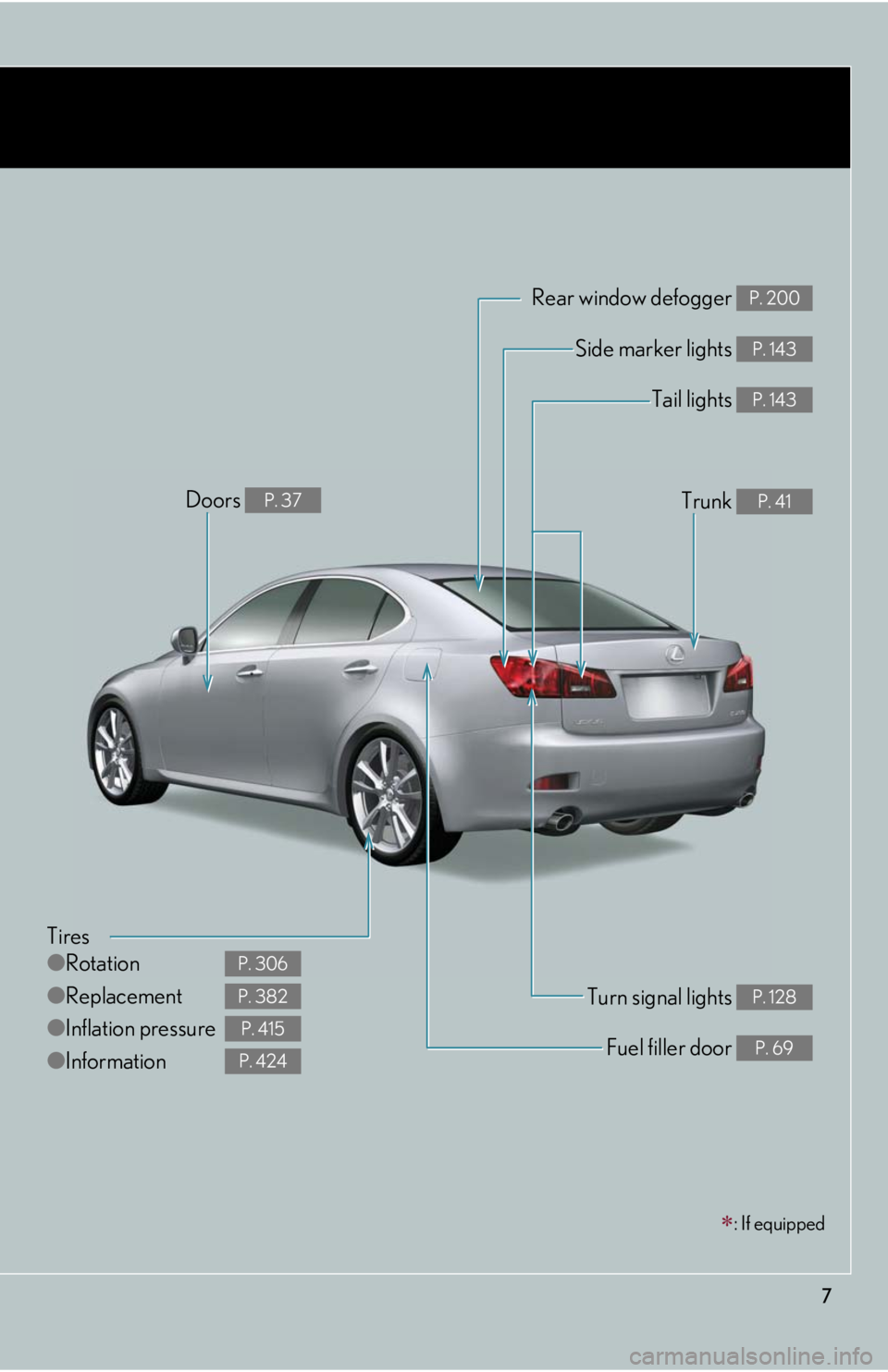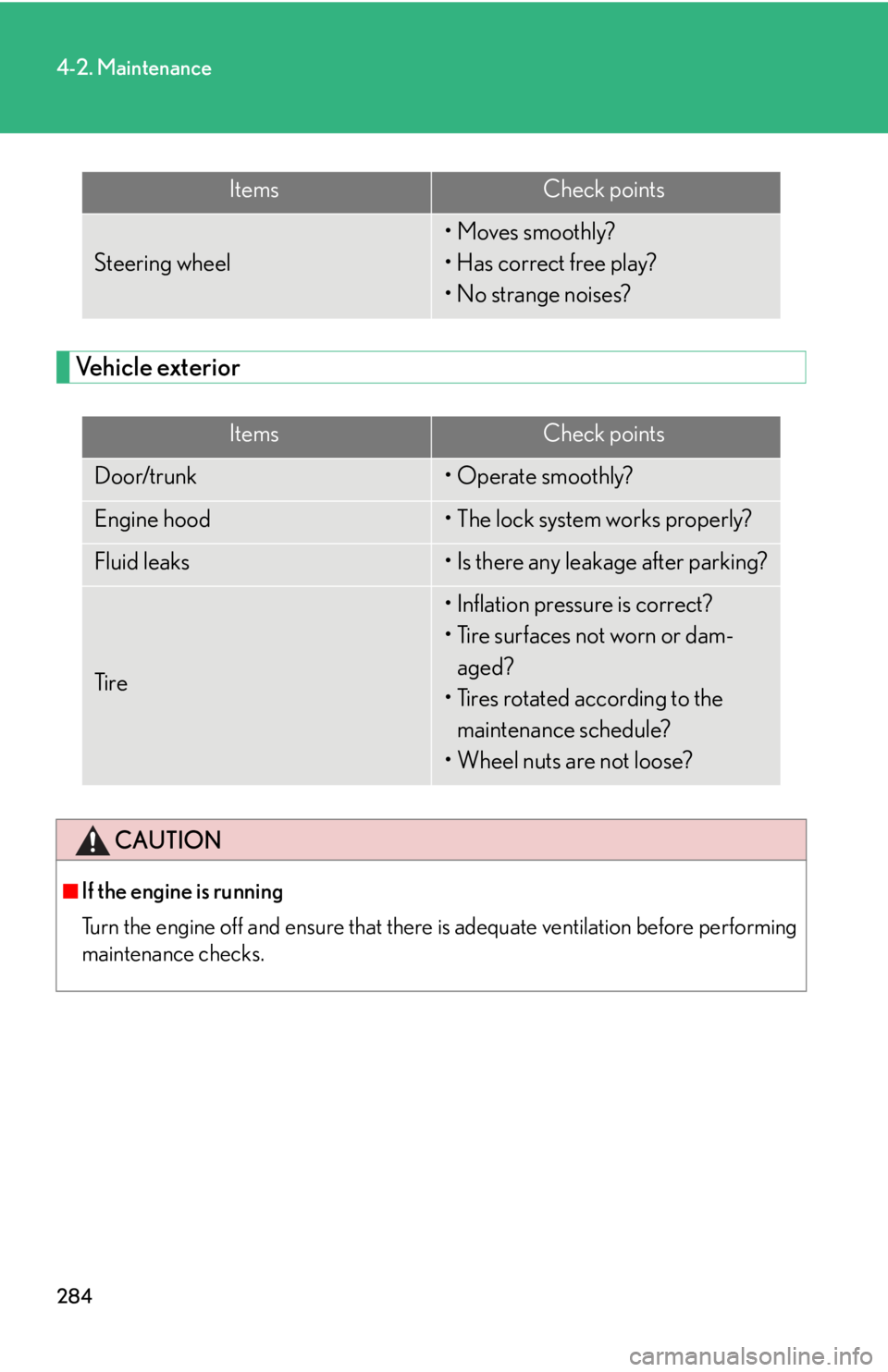run flat Lexus IS250 2008 Using the air conditioning system and defogger / LEXUS 2008 IS250 OWNER'S MANUAL (OM53699U)
[x] Cancel search | Manufacturer: LEXUS, Model Year: 2008, Model line: IS250, Model: Lexus IS250 2008Pages: 464, PDF Size: 6.61 MB
Page 4 of 464

TABLE OF CONTENTSIndex
4
3-4. Using the storage features .... 236List of storage fe atures............... 236
• Glove box..................................... 236
• Console boxes ........................... 237
• Overhead console................... 238
• Cup holders................................. 239
• Bottle holders/ door pockets ................................ 241
3-5. Other interior features........... 242 Sun visors......................................... 242
Vanity mirror .................................. 243
Clock ................................................. 244
Satellite switches .......................... 245
Ashtrays .......................................... 248
Cigarette lighter ........................... 249
Power outlet .................................. 250
Seat heaters ..................................... 251
Seat heaters and ventilators .... 253
Armrest ............................................ 255
Rear sunshade ............................... 256
Trunk storage extension........... 258
Coat hooks ..................................... 259
Floor mat......................................... 260
Trunk features................................. 261
Garage door opener .................. 264
Compass.......................................... 269 4-1. Maintenance and care............ 274
Cleaning and protecting the vehicle exterior................... 274
Cleaning and protecting the vehicle interior .................... 277
4-2. Maintenance............................. 280 Maintenance requir ements .... 280
General maintena nce ................ 282
Emission inspection and maintenance (I/M)
programs ..................................... 285
4-3. Do-it-yourself maintenance............................ 286
Do-it-yourself service precautions .................................. 286
Hood................................................. 289
Positioning a floor jack.............. 290
Engine compartment.................. 292
Tires .................................................. 306
Tire inflation pressure.................. 316
Wheels............................................. 320
Air conditioning filter.................. 322
Electronic key battery ................ 325
Checking and replacing fuses ................................................ 327
Headlight aim.................................. 341
Light bulbs ....................................... 342
4Maintenance and care
Page 7 of 464

7
: If equipped
Tires
●Rotation
● Replacement
● Inflation pressure
● Information
P. 306
P. 382
P. 415
P. 424
Tail lights P. 143
Side marker lights P. 143
Trunk P. 41
Rear window defogger P. 200
Doors P. 37
Fuel filler door P. 69
Turn signal lights P. 128
Page 97 of 464

97
1-7. Safety information
1
Before driving
CAUTION
■Child restraint precautions
●Lexus strongly urges the use of a proper child restraint system that conforms to
the size of the child, installed on the rear seat. According to accident statistics, the
child is safer when properly restrained in the rear seat than in the front seat.
●Never install a rear-facing child restrain t system on the front passenger seat. In
the event of an accident, the force of the rapid inflation of the front passenger air-
bag can cause death or serious injury to the child if the rear-facing child restraint
system is installed on the front passenger seat.
●A forward-facing child restraint system shou ld allowed to be installed on the front
passenger seat only when it is unavoidable. Always move the seat as far back as
possible, because the front passenger airbag could inflate with considerable
speed and force. Otherwise, the child may be killed or seriously injured.
●Do not use the seat belt extender when installing a child restraint system on the
front or rear passenger seat. If installing a child restraint system with the seat belt
extender connected to the seat belt, the seat belt will not securely hold the child
restraint system, which could cause death or serious injury to the child or other
passengers in the event of collision.
●Do not allow the child to lean his/her head or any part of his/her body against the
door or the area of the seat, front pillar, rear pillar or roof side rail from which the
side airbags or curtain shield airbags deploy even if the child is seated in the child
restraint system. It is dangerous if the side airbags and curtain shield airbags
inflate, and the impact could cause death or serious injury to the child.
●Make sure you have complied with all inst allation instructions provided by the
child restraint manufacturer and that the sy stem is properly secured. If it is not
secured properly, it may cause death or seri ous injury to the child in the event of a
sudden stop or accident.
■When the child restraint system is not in use
●Keep the child restraint system properly secu red on the seat even if it is not in use.
Do not store the restraint unsecured in the passenger compartment.
●If it is necessary to detach the child restraint system, remove it from the vehicle or
store it securely in the trunk. This will prevent it from injuring passengers in the
event of a sudden stop or accident.
Page 284 of 464

284
4-2. Maintenance
Vehicle exterior
ItemsCheck points
Steering wheel
• Moves smoothly?
• Has correct free play?
• No strange noises?
ItemsCheck points
Door/trunk• Operate smoothly?
Engine hood• The lock system works properly?
Fluid leaks• Is there any leakage after parking?
Ti r e
• Inflation pressure is correct?
• Tire surfaces not worn or dam-aged?
• Tires rotated according to the maintenance schedule?
• Wheel nuts are not loose?
CAUTION
■If the engine is running
Turn the engine off and ensure that there is adequate ventilation before performing
maintenance checks.
Page 350 of 464

350
5-1. Essential information
If your vehicle needs to be towed
Before towingThe following may indicate a problem with your transmission. Contact
your Lexus dealer before towing.
● The engine is running, but the vehicle will not move.
● The vehicle makes an abnormal sound.
Emergency towing
If a tow truck is not available, in an emergency your vehicle may be tem-
porarily towed using a cable or chain secured to the emergency towing
eyelet(s). This should only attempted on hard, surfaced roads for short
distances at low speeds.
A driver must be in the vehicle to s teer and operate the brakes. The vehi-
cle’s wheels, drive train, axles, steering and brakes must be in good condi-
tion.
Towing eyelets
If towing is necessary, we recommend having your vehicle towed by your
Lexus dealer or a commercial towing se rvice, using a lift-type truck or a flat
bed truck.
Use a safety chain system for all towi ng, and abide by all state/provincial
and local laws.
If towing from the rear, the vehicle’s front wheels and axles must be in good
condition. ( P. 3 5 4 )
If they are damaged, use a to wing dolly or flat bed truck.
Page 356 of 464

356
5-1. Essential information
If you think something is wrong
If you notice any of the following symptoms, your vehicle probably needs
adjustment or repair. Contact your Lexus dealer as soon as possible.
■Visible symptoms
●Fluid leaks under the vehicle
(Water dripping from the air conditioning after use is normal.)
● Flat-looking tires or uneven tire wear
● Engine coolant temper ature gauge needle continually points
higher than normal
■ Audible symptoms
●Changes in exhaust sound
● Excessive tire squeal when cornering
● Strange noises related to the suspension system
● Pinging or other noises related to the engine
■ Operational symptoms
●Engine missing, stumbling or running rough
● Appreciable loss of power
● Vehicle pulls heavily to one side when braking
● Vehicle pulls heavily to one side when driving on a level road
● Loss of brake effectiveness, sp ongy feeling, pedal almost touches
the floor
Page 388 of 464

388
5-2. Steps to take in an emergency
CAUTION
■Using the tire jack
Improper use of the tire jack may lead to death or injuries due to the vehicle sud-
denly falling off the jack.
●Do not use the tire jack for any purpose other than replacing tires or installing and
removing tire chains.
●Only use the tire jack that comes with this vehicle for replacing a flat tire.
Do not use it on other vehicles, and do not use other tire jacks for replacing tires
on this vehicle.
●Always check that the tire jack is securely set to the jack point.
●Do not put any part of your body under the vehicle supported by a jack.
●Do not start or run the engine while your vehicle is supported by the jack.
●Do not raise the vehicle while someone is in it.
●When raising the vehicle, do not put an object on or under the jack.
●Do not raise the vehicle to a height greate r than that required to replace the tire.
●Use a jack stand if it is necessary to get under the vehicle.
Take particular care when lowering the vehicle to ensure that no one working on or
near the vehicle may be injured.
■Replacing a flat tire
Observe the following precautions to reduce the risk of death or serious injury.
●Never use oil or grease on the wheel bolts or wheel nuts.
The oil or grease can cause the wheel nuts to loosen, causing a serious accident.
Remove any oil or grease on the wheel bolts or wheel nuts.
●Have the wheel nuts tightened with a torque wrench to 76 ft•lbf (103 N•m, 10.5
kgf•m) as soon as possible after changing wheels.
Failure to follow these precautions could cause the nuts to loosen and the wheels
may fall off, which could lead to an accident causing death or serious injury.
Page 459 of 464

459
Alphabetical index
TachometerTacho indicator ....................................130
Tachometer ............................................130
Tail lights Switch ........................................................ 143
Talk switch*
Telephone switch*
Theft deterrent system Alarm ........................................................... 74
Engine immobilizer system .............. 72
Theft prevention labels .......................... 76
Tire inflation pressure........................... 316
Tire information Glossary ................................................ 429
Size ........................................................... 426
Tire identification number ............. 426
Uniform tire quality grading..........427
Tires Chains .......................................................183
Checking ............................................... 306
If you have a flat tire.......................... 382
Inflation pressure ................................. 316
Inflation pressure sensor................308
Information.............................................424
Replacing............................................... 382
Rotating tires ........................................ 306
Size ............................................................. 415
Snow tires................................................183
Tools .......................................................... 382
Total load capacity................................. 182 Towing
Dinghy towing ........................... 188, 189
Emergency towing........................... 350
Trailer towing ........................................ 187
TRAC.......................................................... 170
Traction control ...................................... 170
Transmission shift switches ................ 124
Trip meter ................................................. 130
Trunk Extending a space ............................ 258
Opener ........................................................ 41
Trunk light Trunk light ................................................. 42
Wattage ..................................................420
Turn signal lights Replacing light bulbs ........................ 342
Switch........................................................ 128
Wattage ..................................................420T
*: Refer to the “Navigatio n System Owner’s Manual”
Page 462 of 464

462
What to do if...
What to do if...
A tire puncturesP. 3 8 2If you have a flat tire
The engine does not start
P. 3 9 1If the engine will not start
P. 7 2Engine immobilizer system
P. 3 9 4If the vehicle battery is discharged
The shift lever cannot be
moved outP. 3 9 2If the shift lever cannot be shifted
from P
The engine coolant temperature
gauge enters the red zone
Steam can be seen coming
from under the hood
P. 4 0 0If your vehicle overheats
The key is lostP. 3 9 3If you lose your keys
The battery runs outP. 3 9 7If the vehicle battery is discharged
The doors cannot be lockedP. 3 7Doors
The horn begins to soundP. 74Alarm
The vehicle is stuck in mud or
sandP. 4 0 2If the vehicle becomes stuck
Page 464 of 464

464
GAS STATION INFORMATION
Auxiliary catch leverP. 2 8 9Trunk openerP. 4 1Fuel filler door P. 6 9
Hood lock release lever P. 2 8 9Fuel filler door openerP. 6 9Tire inflation pressureP. 4 1 5
Fuel tank capacity17.2 gal. (65 L, 14.3 lmp.gal.)
Fuel typeUnleaded gasoline only P. 70, 409
Cold tire inflation
pressureP. 4 1 5
Engine oil capacity
(Drain and refill)
qt. (L, Imp.qt.)
IS250 IS250
(2WD models) (AWD models) IS350
With filter 6.6 (6.3, 5.5) 6.8 (6.4, 5.7) 6.6 (6.3, 5.5)
Without filter 6.2 (5.9
, 5.2)6.3 (6.0, 5.3) 6.2 (5.9, 5.2)
Engine oil type
Toyota Genuine Motor Oil or equivalent
Oil grade: ILSAC multigrade engine oil P. 410
Recommended oil viscosity: SAE 5W-30